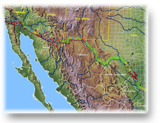SEEDS: The Strategic Evlolution of ESE Data Standards
SEEDS is NASA’s Strategy for Evolution of ESE Data Systems (SEEDS).
The primary goal of the NASA’s Earth Science Enterprise (ESE) standards
process is to facilitate interoperability among components of the ESE network
of data systems. Under the ESE, the Strategy for Evolution of ESE Data Systems
(SEEDS) has instituted a process of peer review for standards adoption used
by NASA funded Earth science activities. An important motivation underlying
the process is a realization that documentation of established practices used
by and targeted to particular science measurement data sets will enable greater
flexibility and interoperability among data systems.(http://www.earth.nasa.gov/)
- Engage the data user/data producer community in establishing
and maintaining a unifying framework and management guidelines
- Allow new missions, science teams, and applications projects
to implement their own data systems and services while maintaining an aggregated
system-wide interoperability.
This
REASoN project will follow SEEDS standards and suggestions to assist the
USBP,
SDPD, and other cooperating agencies
having border security and homeland defense responsibilities, in establishing
and maintaining a unifying exchange and sharing framework of remotely sensed
imagery and GIS layers. These agencies are actively seeking such a system. Under
a web-based spatial decision support system, multiple agencies can rapidly share
and exchange their GIS databases and remotely sensed imagery for application
to multiple homeland security tasks.
Such information exchange is essential to pre-emergency planning, critical
first response actions, relief efforts, and community recovery. Furthermore,
such information can greatly enhance daily operations and cooperation among
agencies in meeting homeland defense responsibilities. Exploratory exchanges
of GIS and remotely sensed imagery of limited scope demonstrated that significant
benefits accrue to agencies involved with border security, law enforcement,
disaster response (forest fires), and humanitarian rescues.
Standards
and Interface Protocols
This
project seeks to establish and implement a set of standards and interface protocols
that will allow rapid exchange of geo-spatial data among participating agencies.
By utilizing a standardized web mapping interface (OGC Web Map Server Interfaces
Implementation Specification) and XML-based metadata frameworks (ISO 19115),
individual participating agencies can implement their own data systems and services
while maintaining an aggregated system-wide interoperability through multiple
data warehouses and web-based decision support systems.
Levels
of Services
Users
will be able to access on-line mapping facilities containing extensive imagery
and geo-spatial data sets, access spatial analysis tools and perform spatial
analyses, and query high quality remote sensing data via a standard web browser
utilizing wireless networking technologies (IEEE 802.11b, Wi-Fi standard). The
spatial data products and hardware prototype technologies provided by the project
answer time urgent and high priority needs of the USBP and sister participating
agencies. SDSU and its participating partners are committed to the timely development
and transfer of the needed geo-spatial technologies and products.
Software
Reuse
Parts
of the web-based GIS and SDSS developed in this project require development
of Java applets for image processing and display. Software will be developed
using modularized Java applets that can be reused in other future software applications.
Java was specifically selected because it is an object oriented, open source
language designed for the distributed network environment, such as the Internet
and Intranet. The Java code is capable of providing advanced image processing
required for geo-spatial analysis such as image change detection. Code modules
developed during current and previous NASA ARC projects at SDSU support the
software reuse principle. Code modules developed during this and follow-on SDSS
projects will be available for reuse.
Technology
Infusion and Evolution Strategy
A
three-phase strategy will be used:
- Adopt current software packages, ArcIMS, Image Web Server, Java applets,
and wireless communication technology (3G, Wi-Fi, and Wi-Fi5).
- Customize these packages and develop specific functions for USBP and the
tasks of homeland security.
- Migrate the current development to comprehensive GIS web services frameworks
(by using SOAP, WSDL, and UUDI) and the next generation of wireless communication
technologies (4G) to provide a comprehensive, reliable, and secured SDSS.
Data
Format and Content
The
proposed data format is ESRI Shapefiles and the choice of databases is Spatial
Database Engine (SDE). Shapefiles are an industry standard GIS format, that
is forecast to remain a standard for at least the next decade. It is the standard
format used by all participating agencies of this project. Shapefiles can be
used directly in the proposed web mapping service package (ArcIMS and Image
Web Server) without any pre-processing or conversion procedures.
The metadata format adopted by this project is the current FGDC metadata
standard and XML-based ISO 19115 (International standard) implemented through
ESRI’s ArcCatalog and ArcIMS Metadata Server. FGDC’s metadata
standard is the leading standard currently in the GIS community.
The proposed SDSS will support standard remotely sensed image formats including,
but not limited to HDF, BMP, BSQ, BIL, BIP, GRID, IMAGINE (img), JPEG
National Image Transfer Format (NITF), Sun rasterfiles, TIFF, TIFF/LZW compressed,
and ECW compression. These formats are widely accepted industry formats supported
by the leading image processing and GIS software applications. These imagery
formats are the standard formats commonly used by all participating agencies
of this project.
Interface
Standards
The
principal external interface adopted in this research will be web-based communication
protocols and interfaces. The data warehouse and its associated metadata will
be based on the Z39.50 protocol to provide the functions of searching, indexing
and query of metadata from other systems or outside clearinghouse nodes. The
data warehouse nodes will join FGDC’s National Spatial Data Infrastructure
nodes by implementing the ISITE software and Z39.50 protocol on the data warehouse
server.
Web mapping services will be based on the OpenGIS Web Map Server Interface
Implementation Specification for sharing and exchanging on-line mapping services
and remote sensing imagery display functions. The adoption of the OpenGIS
WMS will ensure interoperability of web map servers and open accessibility
from other programs or servers.


